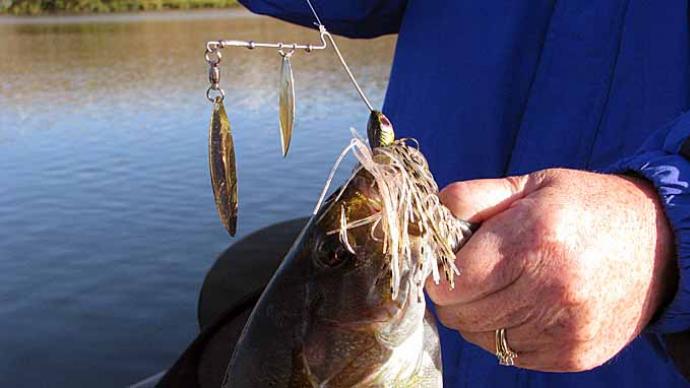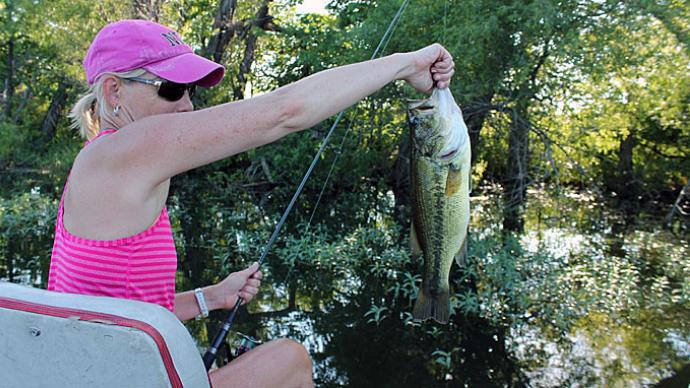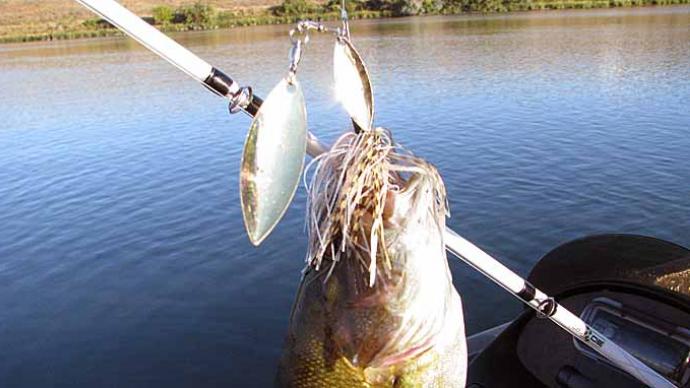
If lures are to fishing as tools are to an automobile mechanic, then the spinnerbait could be the adjustable wrench in your toolbox. I say that because it’s one lure that fits so many different styles of fishing and water conditions.
It is probably the most versatile lure a bass angler can own. You can fish a 1/8-ounce spinnerbait for clear shallow water or go up to 2 ounces and fish along deep ledges. You can alter the way it looks, sounds and feels to the fish, as well as how it rides through the water, by simply changing blades.
I’ll never forget the first time I saw my first spinnerbait. I was about 17 years old when I met a man holding the biggest stringer of bass I’d ever laid eyes upon. He told me he caught them all on a spinnerbait and gave me some advice.
“The muddier the water, the bigger the fish,” he said. “And there isn’t a better lure for muddy water than the spinnerbait.”
I found that to be true in my professional career and later in my recreational fishing. The spinnerbait probably is the greatest tool in fishing for fooling muddy-water fish. But I’ve also learned that the spinnerbait can be equally effective in clear water.
The most important aspect for me is that a spinnerbait has two blades. Tandem blades ensure that you always have at least one blade turning, especially if you bang into cover, and keep the lure from falling to one side or getting snagged. Single blades will catch fish, but two seem to be more effective for me.
When fishing muddy water, I want a bait with Colorado blades because of the amount of vibration they emit. If the water is clear and has vegetation, I would choose one with tandem willow-leaf blades because they turn through the grass better than rounded blades and throw off less flash.
A good all-around blade combination is one with a Colorado and an Indiana blade. This combination won the Bassmaster Classic and a Missouri Invitation for me back in my tournament days. It also is the key to the Hank Parker Classic spinnerbait that Mann’s makes and has sold so well over the years.
The Hank Parker Classic comes in a variety of weights, but the 3/4-ounce is my favorite. The heavier bait can be fished quickly near the surface, slow rolled on the bottom or dropped abruptly in the shade of a stump or log to trigger reactionary strikes.
I throw three colors 99 percent of the time – chartreuse, chartreuse/white and white. I’ll fish skirts with blue or lime green in them the other 1 percent of the time.
I use chartreuse in muddy water or when the sky is cloudy, but white when it’s bright or the water is clear. The chartreuse/white skirt works well when you’ve got conditions somewhere in between.
I prefer light wire in the shaft of my spinnerbaits because it emits a lot of vibration, which I believe attracts more strikes. Admittedly, the light wire will get out of shape more frequently, so you have to tune it periodically. But when you’re catching more fish, it’s worth the nuisance.
The length of the wire between the head of the lure and the line tie is equally critical. I favor lures with a shorter distance between the two points because I’ve found it makes the bait more weedless.
Also, I want the top wire that supports the blades to extend over the middle of the hook. This makes the lure more weedless and erases any concerns of snagging that I may have when working the bait through heavy cover.
Finally, I want a trailer hook on my spinnerbait. It will not only catch more fish, but it acts like a keel and keeps the lure running true. A spinnerbait that wobbles or leans tends to snag more often.
You can find more articles, quick tips and much more at HankParker.com.




